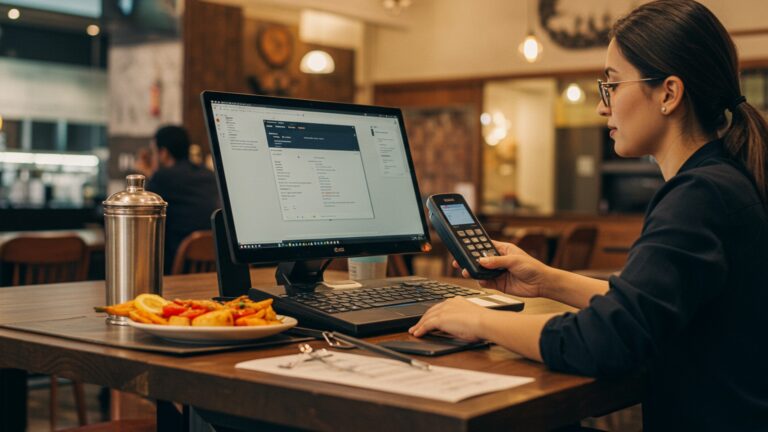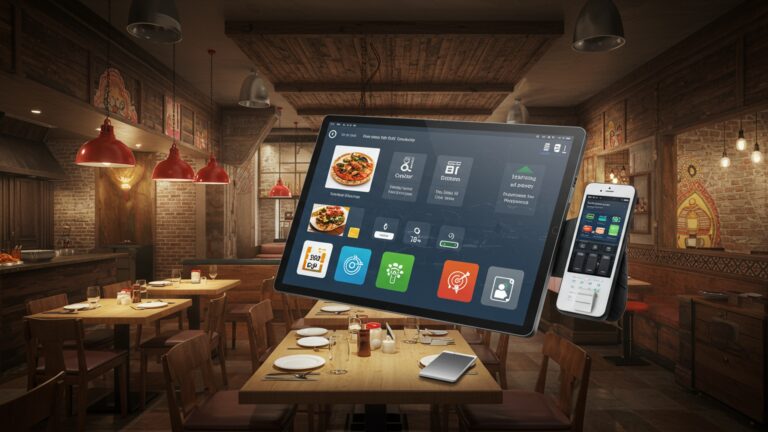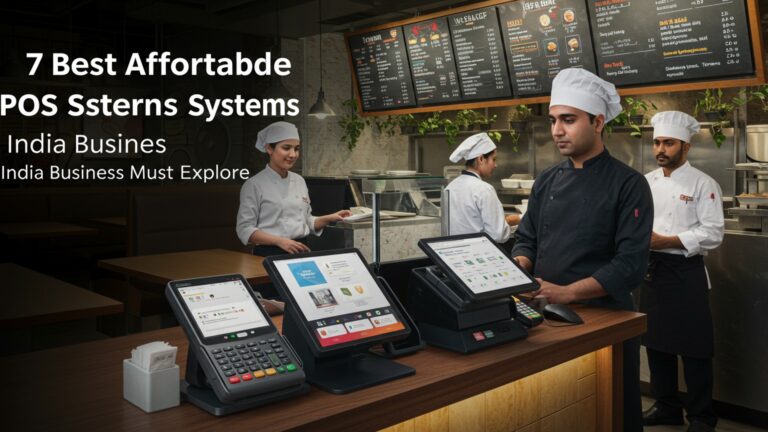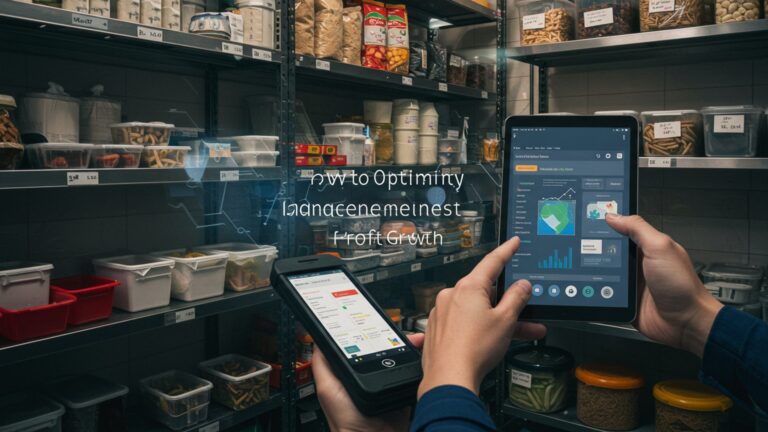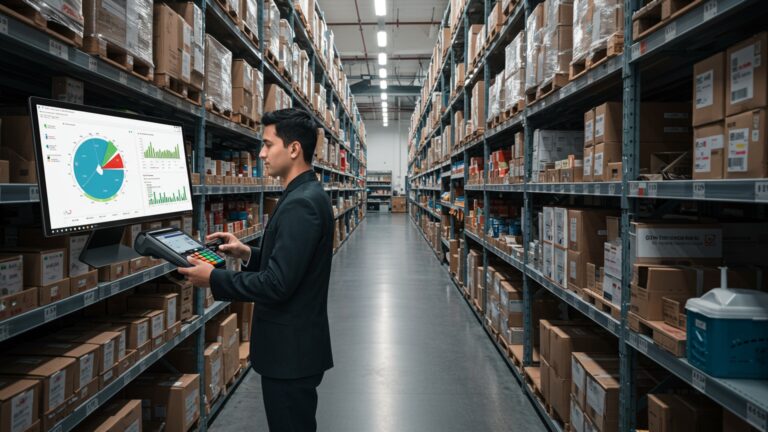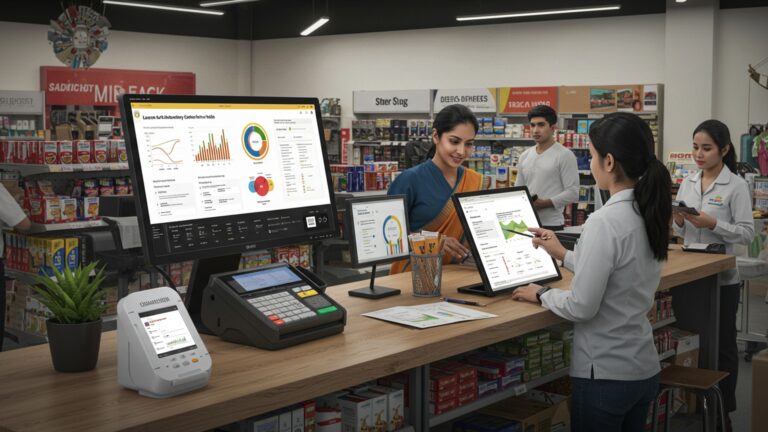How to Get the Most Affordable POS for Your Indian Restaurant Business
Indian restaurant owners, navigating razor-thin margins and escalating operational complexities, critically need an efficient Point-of-Sale (POS) system that doesn’t become another significant overhead. The market demands robust solutions capable of seamless online order integration and handling the ubiquitous UPI payments, making a basic billing setup obsolete. Astute operators prioritize a system that expertly manages everything from intricate regional menu variations to real-time inventory and GST compliance. The real quest involves identifying the cheapest restaurant POS India provides, one that delivers essential functionality and truly drives efficiency, rather than just processing transactions. This strategic approach transforms POS selection from a simple cost into an empowering investment for sustainable growth in today’s fiercely competitive culinary landscape.
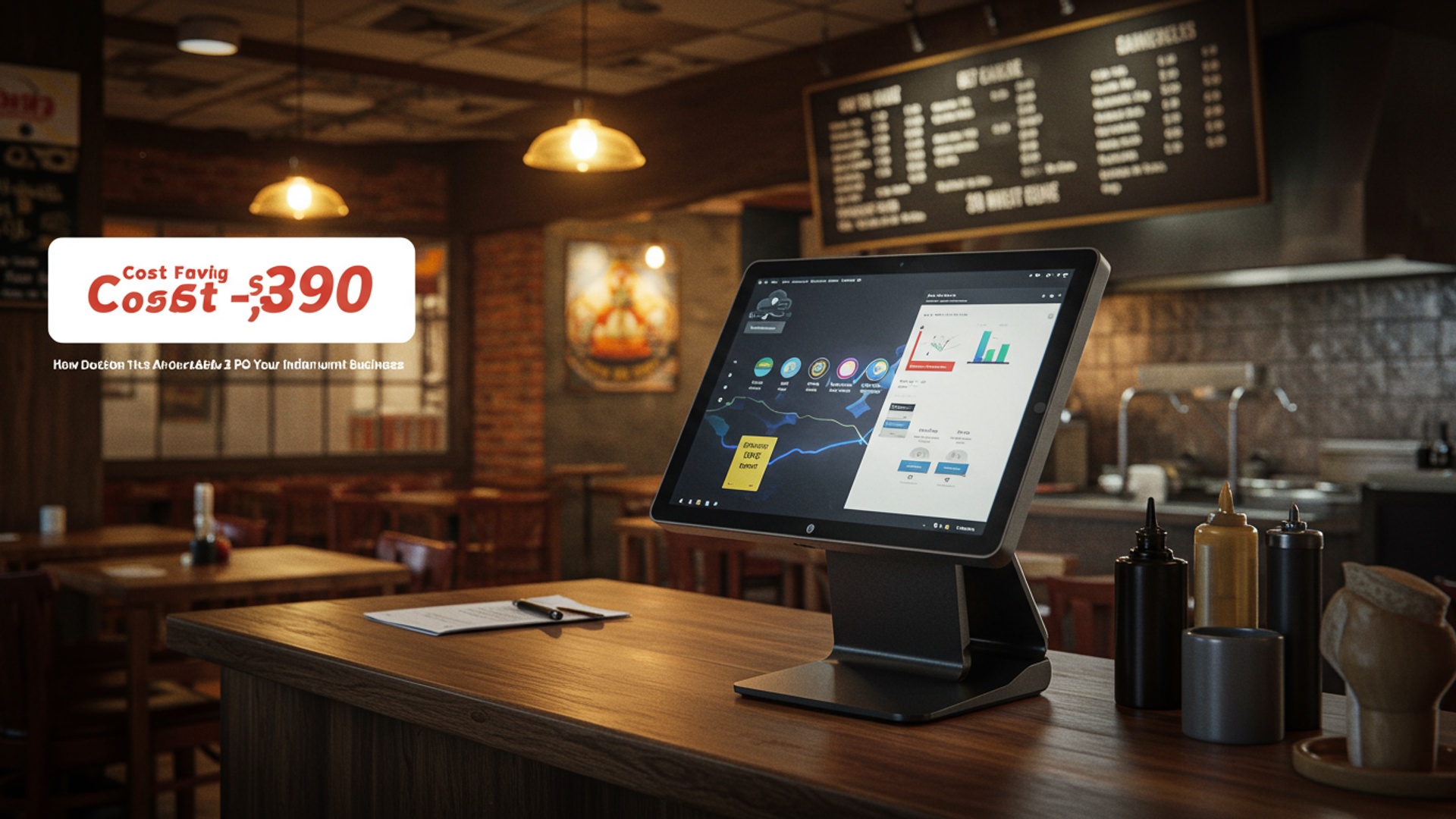
Understanding the Power of a Point-of-Sale (POS) System for Your Indian Restaurant
A Point-of-Sale (POS) system is far more than just a glorified cash register; it’s the central nervous system of any modern restaurant, especially for the dynamic environment of an Indian eatery. At its core, a POS system is a combination of hardware and software that processes transactions. its capabilities extend dramatically beyond simple billing. For an Indian restaurant, where managing diverse menus, complex order modifications. often a high volume of takeaway and delivery orders is common, a robust POS system is crucial for streamlining operations, enhancing customer experience. ultimately, boosting profitability. It helps with everything from taking orders and managing tables to tracking inventory, processing payments. generating critical business reports. Even for smaller establishments, having the Cheapest restaurant POS India can significantly optimize daily tasks, reduce errors. provide valuable insights into sales performance.
Deconstructing the Core Components of a Restaurant POS System
To truly interpret how to find the most affordable POS, it’s essential to know what makes up a typical system.
-
- Hardware
These are the physical components you interact with.
-
-
- Touchscreen Terminals
-
The primary interface for staff to take orders, process payments. manage tables. These can range from dedicated POS terminals to regular tablets (like iPads or Android tablets) or even desktop computers.
-
-
- Receipt Printers
-
For printing customer bills, kitchen order tickets (KOTs). bar order tickets (BOTs).
-
-
- Cash Drawer
-
A secure place to store cash transactions.
-
-
- Card Readers/Payment Terminals
-
Devices for processing debit and credit card payments, often integrated with the POS software. In India, these often include UPI QR code generation capabilities.
-
-
- Kitchen Display System (KDS)
-
Digital screens in the kitchen that display incoming orders, replacing paper KOTs, improving efficiency and reducing errors.
-
- Software
This is the brain of the POS system. It’s the application that runs on the hardware, managing all the functions from order entry to reporting. The software is where you configure your menu, track sales, manage inventory. access analytical data.
-
- Payment Processing
This involves the integration with various payment gateways and banks to securely handle electronic transactions. Modern Indian POS systems often support a wide array of payment methods, including UPI, debit/credit cards, mobile wallets. net banking.
-
- Network Connectivity
A stable internet connection is vital for most modern cloud-based POS systems, enabling data synchronization, cloud backups. remote access.
Essential Features to Prioritize for an Affordable Indian Restaurant POS
When seeking the Cheapest restaurant POS India, it’s critical to distinguish between ‘must-have’ features that drive operational efficiency and ‘nice-to-have’ advanced functionalities that can significantly increase costs. Prioritizing core functionalities will ensure you get the best value for your investment.
-
- Efficient Order Management
The ability to quickly take orders, customize items (e. g. , “less spicy,” “extra cheese”), split bills. manage table statuses is fundamental. For Indian cuisine, precise customization is often key.
-
- Robust Billing & Invoicing
Generating accurate, GST-compliant bills, applying discounts. handling multiple payment methods seamlessly.
-
- Basic Inventory Management
Tracking your raw materials (e. g. , spices, vegetables, proteins) and finished dishes. While advanced systems offer detailed recipe management, a basic system should alert you to low stock for critical ingredients. This is invaluable for minimizing waste in Indian kitchens.
-
- Table Management (for Dine-in)
A visual layout of your restaurant to manage table assignments, track order status per table. merge/split tables.
-
- Reporting & Analytics (Core)
Access to essential reports like daily sales, peak hours, most popular dishes. staff performance. These insights are crucial for making informed business decisions.
-
- Basic Customer Relationship Management (CRM)
Simple features like storing customer contact details and tracking their order history can help in building loyalty programs.
-
- Integration with Popular Payment Gateways
Seamless integration with local payment options like UPI, PayTM, Google Pay. major card networks is non-negotiable for the Indian market.
-
- User-Friendly Interface
An intuitive system reduces training time for staff, which translates directly into cost savings and faster adoption.
Avoid systems that heavily push features like multi-location management (if you only have one outlet), advanced loyalty programs with complex tiers, or highly specialized KDS integrations if your budget is tight. These can always be added as your business grows.
Exploring Different Types of POS Systems and Their Cost Implications
The architecture of a POS system significantly impacts its cost, scalability. operational requirements. Understanding these differences is key to identifying the Cheapest restaurant POS India that fits your needs.
-
- Cloud-Based POS (Software as a Service – SaaS)
- Explanation
- Cloud-Based POS (Software as a Service – SaaS)
The software is hosted on remote servers and accessed via the internet through a web browser or an app on your device (tablet, smartphone, or PC).
-
-
- Pros
- Lower Upfront Cost
- Pros
-
Typically involves a monthly or annual subscription fee, eliminating large initial software purchases. This makes it an attractive option for finding the Cheapest restaurant POS India.
-
-
-
- Remote Access
-
-
Manage your restaurant and view reports from anywhere with an internet connection.
-
-
-
- Automatic Updates
-
-
Software updates and maintenance are handled by the vendor, ensuring you always have the latest features and security.
-
-
-
- Scalability
-
-
Easily add more terminals or features as your business grows.
-
-
-
- Data Backup
-
-
Data is usually backed up in the cloud, reducing the risk of data loss.
-
-
- Cons
- Internet Dependency
- Cons
-
Requires a stable internet connection to function optimally. Some systems offer an offline mode. full functionality usually needs connectivity.
-
-
-
- Subscription Fees
-
-
Ongoing costs, though often manageable.
-
-
-
- Data Security
-
-
Reliance on the vendor for data security, though reputable providers have robust measures.
-
-
- Cost Implication
-
Generally the most cost-effective option for initial setup and ongoing management for small to medium-sized Indian restaurants.
-
- On-Premise POS (Legacy Systems)
- Explanation
- On-Premise POS (Legacy Systems)
The POS software is installed directly on your restaurant’s local servers and hardware.
-
-
- Pros
- Full Data Control
- Pros
-
Your data resides locally, giving you complete ownership.
-
-
-
- Less Internet Dependency
-
-
Can function without a constant internet connection for core operations.
-
-
-
- High Customization
-
-
Often allows for more bespoke modifications.
-
-
- Cons
- High Upfront Cost
- Cons
-
Requires significant investment in software licenses, servers. dedicated hardware.
-
-
-
- Maintenance & Updates
-
-
You are responsible for software updates, security patches. hardware maintenance, which can be complex and costly.
-
-
-
- Limited Remote Access
-
-
Accessing data remotely often requires additional setup and security measures.
-
-
-
- Less Scalable
-
-
Adding new terminals or features can be more complex and expensive.
-
-
- Cost Implication
-
While offering more control, these systems are significantly more expensive in the long run due to initial investment, maintenance. IT support, making them less suitable if your goal is the Cheapest restaurant POS India.
-
- Hybrid Systems
These combine aspects of both cloud-based and on-premise systems, offering some local processing capabilities with cloud backup and synchronization. They aim to provide the best of both worlds but can sometimes introduce more complexity.
Key Factors That Influence POS Pricing in India
Understanding the various components that contribute to the overall cost of a POS system is crucial for smart budgeting and finding the Cheapest restaurant POS India that still meets your operational needs.
-
- Subscription Model
For cloud-based systems, this is the primary ongoing cost. Prices vary based on:
-
-
- Features Included
-
Basic plans are cheaper, advanced plans with more modules (e. g. , detailed inventory, CRM, online ordering integration) cost more.
-
-
- Number of Terminals/Users
-
Some vendors charge per terminal, others per user, or based on the number of transactions.
-
-
- Payment Frequency
-
Annual subscriptions are often cheaper than monthly ones.
-
- Hardware Costs
The physical devices required can be a significant upfront expense.
-
-
- Dedicated POS Hardware
-
Specialized terminals, printers. KDS can be expensive.
-
-
- Off-the-Shelf Devices
-
Using existing tablets, smartphones, or PCs can drastically reduce hardware costs.
-
-
- Rental vs. Purchase
-
Some vendors offer hardware on rent, which might seem cheaper initially but can be more expensive long-term.
-
- Transaction Fees
These are charges levied by payment processors for each electronic transaction. While not directly a POS cost, they are an integral part of your payment ecosystem and vary based on the payment gateway and transaction volume.
-
- Setup & Installation Fees
Some vendors charge a one-time fee for initial setup, menu configuration. system installation. Look for providers that offer free or minimal setup.
-
- Training & Support
While basic support is usually included, premium support, on-site training, or dedicated account managers can incur additional costs. Ensure the basic support offered meets your needs.
-
- Customization & Add-ons
Any specific customization, integration with third-party software (e. g. , accounting software), or additional modules will add to the price.
Actionable Strategies to Secure the Cheapest Restaurant POS India
Navigating the POS market can be daunting. with a strategic approach, you can find an affordable system without compromising essential functionality.
-
- Clearly Define Your Needs
Before even looking at vendors, list your absolute must-have features. Don’t pay for advanced functionalities you won’t use. For a small Indian restaurant, often basic order management, billing. simple inventory are sufficient initially.
-
- Start Lean, Scale Later
Many cloud-based POS providers offer tiered pricing. Begin with their most basic, cost-effective plan and upgrade as your business grows and your needs evolve. This is a smart way to get the Cheapest restaurant POS India upfront.
-
- Prioritize Cloud-Based Solutions
As discussed, SaaS models generally have lower upfront costs and manageable recurring fees, making them the most budget-friendly entry point for most Indian restaurants.
-
- Leverage Free Trials and Demos
Most reputable POS providers offer free trials or product demos. Utilize these to test the system’s ease of use, features. compatibility with your operations before committing financially.
-
- Negotiate with Vendors
Don’t hesitate to negotiate, especially if you’re looking at annual subscriptions or bundling hardware. Ask for discounts, waivers on setup fees, or extended trial periods.
-
- Consider Re-purposing Existing Hardware
If you already have tablets, smartphones, or desktop computers, see if they are compatible with cloud-based POS software. This can drastically cut down on hardware costs.
-
- Look for Bundle Deals
Some vendors offer packages that include basic hardware (e. g. , a tablet, printer, cash drawer) along with the software subscription at a discounted rate.
-
- Compare Total Cost of Ownership (TCO)
Don’t just look at the monthly subscription fee. Factor in hardware costs, setup fees, potential transaction charges. any additional support costs over a 1-3 year period to get a realistic picture of the Cheapest restaurant POS India for your business.
A Comparison of Popular Affordable POS Options for Indian Restaurants
To illustrate the landscape of affordable POS solutions, here’s a comparative table featuring general types of offerings you might encounter in the Indian market. Please note that specific features and pricing can vary widely between actual providers and should be verified directly with vendors. This table aims to guide your understanding of what to look for when seeking the Cheapest restaurant POS India.
| POS System Type/Provider (Example) | Key Features | Pricing Model (Indicative) | Best Suited For | Considerations |
|---|---|---|---|---|
| Basic Cloud POS (e. g. , Loyverse, Petpooja Starter) | Order Management, Billing, Basic Inventory, Sales Reporting, Online Ordering Integration (basic), Customer Management. | Free basic plan; Paid plans often start from ₹500-₹1500/month (per terminal or based on features). | Small cafes, quick-service restaurants, food trucks, new ventures looking for the Cheapest restaurant POS India. | Often requires you to use your own tablet/PC. Advanced features (e. g. , detailed loyalty, multi-location) are typically add-ons or available in higher-tier plans. Support might be limited in free/basic plans. |
| Mid-Tier Cloud POS (e. g. , UrbanPiper, Posist Lite) | Comprehensive Order & Table Management, Advanced Inventory, CRM, Supplier Management, Robust Online Ordering Integrations, Basic Kitchen Display System (KDS). | Starts from ₹1500-₹3000/month (per terminal or based on modules/transaction volume). | Mid-sized dine-in restaurants, cloud kitchens, growing businesses needing more automation and better integration with food aggregators. | Hardware usually purchased separately. May have tiered pricing based on features or number of orders/transactions. More robust features come at a higher cost. |
| Hardware-Bundled POS (e. g. , specific vendor packages) | Integrated software and dedicated hardware (e. g. , touchscreen terminal, receipt printer, cash drawer). Core POS features for billing and order management. | One-time hardware cost (ranging from ₹20,000-₹50,000) + lower monthly/annual software fee (₹500-₹1000). | Restaurants preferring an all-in-one physical setup, those less tech-savvy, or businesses seeking a turnkey solution without piecemeal hardware sourcing. | Less flexibility in hardware choice. Software features might be more basic compared to pure SaaS. Upfront cost is higher due to hardware. |
Navigating Implementation and Training for Cost Efficiency
Beyond the purchase price, the costs associated with implementing a POS system and training your staff can add up. Smart planning here can help keep your overall investment in the Cheapest restaurant POS India truly affordable.
-
- DIY Setup vs. Professional Installation
Many cloud-based POS systems are designed for intuitive self-setup. If you’re comfortable with basic tech, setting up your menu, tables. staff accounts yourself can save on professional installation fees, which can range from a few hundred to several thousand rupees. Always check if the vendor provides clear, step-by-step guides or video tutorials.
-
- User Training
Choose systems with highly intuitive interfaces. A system that’s easy to learn will minimize the time and resources you need to spend on staff training. Look for vendors who offer free online tutorials, knowledge bases, or community forums for support. Avoid systems that require extensive, paid training sessions if your budget is tight. Practical, hands-on training during slower hours, led by a designated staff member, can be very effective and free.
-
- Ongoing Support
grasp what level of support is included in your subscription. Basic plans might offer email or chat support with slower response times, while premium plans could include 24/7 phone support or dedicated account managers. For an affordable option, ensure the basic support is sufficient for urgent issues, as paying extra for premium support can quickly erode your cost savings.
Real-World Insights: How ‘The Spice Route Cafe’ Optimized Its POS Investment
Consider the hypothetical case of ‘The Spice Route Cafe,’ a small, family-run Indian restaurant that opened in Bengaluru with a tight budget. The owners, Mr. and Mrs. Sharma, knew they needed a modern POS to compete but were wary of high costs. Their goal was to find the Cheapest restaurant POS India that could handle their core operations. Instead of opting for an expensive on-premise system or a feature-rich, high-tier cloud solution, they chose a basic cloud-based POS provider (let’s call it “FoodieFlow POS”). Here’s how they optimized their investment:
-
- Leveraged Existing Hardware
They already had a couple of sturdy Android tablets they weren’t using. “FoodieFlow POS” was compatible, allowing them to use these as their main POS terminals, saving them a significant upfront cost on dedicated hardware.
-
- Started with a Basic Plan
They subscribed to FoodieFlow’s entry-level monthly plan, which included essential features like order taking, table management, basic billing. simple sales reports. They didn’t pay for advanced inventory or complex loyalty programs they didn’t need yet.
-
- Self-Setup & Training
Mr. Sharma, with a basic understanding of technology, followed the online tutorials to set up their menu and staff accounts. They conducted staff training during off-peak hours, using the system’s intuitive interface, which minimized the learning curve.
-
- Focused on Core Benefits
By focusing on these essential functions, ‘The Spice Route Cafe’ immediately saw benefits: faster order processing, fewer billing errors, accurate daily sales summaries. better tracking of popular dishes. This allowed them to make data-driven decisions on menu adjustments and promotions, despite having the Cheapest restaurant POS India available.
This approach allowed ‘The Spice Route Cafe’ to operate efficiently, manage their costs. build a solid foundation for future growth without overspending on their initial POS investment.
Key Actionable Takeaways for Smart POS Procurement
To ensure you get the most affordable and effective POS system for your Indian restaurant, remember these critical steps:
-
- Precisely Assess Your Needs
Differentiate between essential and desirable features. Don’t pay for functionalities you won’t use.
-
- Prioritize Cloud-Based Solutions
These generally offer the lowest upfront costs and greater flexibility, making them ideal for the Cheapest restaurant POS India.
-
- Focus on Total Cost of Ownership (TCO)
Look beyond just the monthly subscription. Consider hardware, setup, training. ongoing support costs over time.
-
- Leverage Free Trials and Demos
Always test the system thoroughly before making a financial commitment.
-
- Negotiate Smartly
Don’t shy away from negotiating on pricing, especially for annual plans or hardware bundles.
-
- Consider Scalability
Choose a system that can grow with your business, allowing you to add features or terminals as needed without a complete overhaul.
-
- Utilize Existing Hardware
If possible, use your current tablets or PCs to reduce initial hardware expenditure.
Conclusion
Finding the most affordable POS for your Indian restaurant doesn’t mean settling for less; it’s about smart strategic choices. Begin by meticulously evaluating your specific needs – do you truly require advanced inventory for a small dosa corner, or is robust KOT and UPI integration your priority? My own experience helping a bustling chai shop in Nashik taught me that cloud-based solutions, often with flexible subscription models, offer incredible value, eliminating hefty upfront hardware costs. Embrace current trends like QR code ordering and seamless digital payment integration, which are non-negotiable for today’s Indian diners. Remember, the goal isn’t just cheapness. cost-effectiveness. Prioritise systems that offer essential features for Indian restaurants, as explored in Discover 7 Essential Android POS Features for Indian Restaurants, without overpaying for unnecessary bells and whistles. Leverage free trials and negotiate package deals. By making informed decisions, you’re not just saving money; you’re investing in efficiency, customer satisfaction. the sustained growth of your culinary venture, turning every transaction into a step forward.
More Articles
How to Choose and Use a POS System for Inventory Management in India
7 Essential Tips for Finding Affordable POS Software Price in India
Learn How to Select the Best POS Software in India for Success
7 Essential Features Your POS Billing Software Needs for GST Compliance
Unlock Growth with 7 Essential Free POS Software Options for Small Businesses
FAQs
What’s the absolute first step to finding a budget-friendly POS for my Indian restaurant?
Start by figuring out exactly what your restaurant needs. Do you just need basic billing, or do you also want inventory management, online ordering integration, or table management? Don’t pay for features you won’t use. List your must-haves versus nice-to-haves clearly.
Are there specific POS systems that are generally cheaper for restaurants in India?
Yes, many local Indian POS providers offer competitive pricing tailored for the Indian market, often with lower subscription fees or one-time payment options compared to global brands. Look for companies that specifically cater to the Indian restaurant sector, as they interpret local requirements and budget constraints better.
How can I make sure I’m not overpaying for features I don’t really need?
Focus on core functionalities. If your restaurant is small or new, you probably don’t need complex CRM or multi-branch management. Prioritize billing, order taking, basic inventory. perhaps a Kitchen Display System (KDS). Ask providers for a feature breakdown and ensure you can customize your plan to remove unnecessary add-ons.
Should I consider a cloud-based POS or one that’s installed locally? Which is cheaper in the long run?
Cloud-based POS systems often have lower upfront costs because they don’t require expensive server hardware and operate on a subscription model, which can be more budget-friendly initially. They also offer remote access and automatic updates. Locally installed systems might have higher upfront costs but no recurring subscription, which could be cheaper over many years if you don’t need updates or remote access. For most modern Indian restaurants, cloud is usually more practical and often more affordable overall.
What kind of hidden costs should I watch out for with POS systems?
Be wary of extra charges for hardware, installation, training, customer support (especially after the initial period), additional user licenses, specific integrations (like payment gateways or online delivery platforms), or data migration. Always ask for a detailed, all-inclusive quote that covers everything you need.
Is it possible to get a POS that works with my existing hardware to save money?
Absolutely! Many modern POS software solutions are hardware-agnostic, meaning they can run on standard Android tablets, iPads, or even existing Windows PCs. This can significantly cut down your initial investment if you don’t need to buy dedicated POS terminals, printers, or cash drawers, as long as your existing equipment is compatible.
What about free POS options? Are they any good for an Indian restaurant?
While some ‘free’ POS options exist, they often come with very limited features, transaction fees, or push you towards their payment processing. For a serious restaurant business, even a small one, a paid, feature-rich system usually offers better reliability, support. scalability, making it more cost-effective in the long run. Free versions might be okay for very basic billing. probably not for a full-fledged restaurant operation.
How crucial is local support when choosing an affordable POS in India?
Very vital! Good local support means faster resolution of issues, especially during peak hours. An affordable system isn’t truly affordable if downtime costs you business and revenue. Ensure the provider has a strong support presence in India, ideally with local language options and quick response times, even for their most basic plans.

